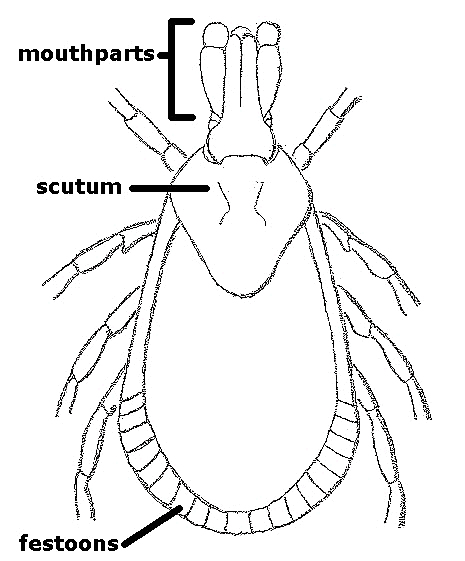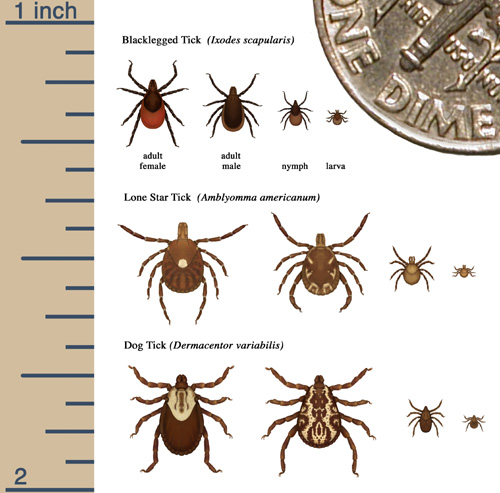This key is intended to aid in the identification of unfed ADULT ticks. Ticks shorter than 3mm (1/8-inch) are usually immature and more difficult to identify. These should be sent to experts.
 Does the rear edge of the tick appear segmented with several square plates known as festoons?
Does the rear edge of the tick appear segmented with several square plates known as festoons?
(See illustration to the right.)
YES: Go to 3.
NO: Go to 2.
- Are the mouthparts long, narrow and visible from above the tick?
YES: This may be a blacklegged tick, also know as the “deer tick” (Ixodes scapularis). Blacklegged ticks are most common in northern Illinois and around river corridors. They range from dark brown to bright red and have black legs. These ticks can transmit Lyme and other diseases. However, because there are many similar Ixodes species, they should be sent to an expert for species identification.
NO: This is a “soft tick” (Argasidae). These ticks are soft, while all other ticks mentioned  here are “hard ticks.” Soft ticks rarely, if ever, transmit disease in Illinois. They are often associated with domestic birds upon which they feed.
here are “hard ticks.” Soft ticks rarely, if ever, transmit disease in Illinois. They are often associated with domestic birds upon which they feed.
(See illustration to the right.)
- Are there irregular silvery white marks in the center of the tick’s back?
YES: This is an American dog tick (Dermacentor variabilis) , the most common tick found throughout Illinois. It usually feeds on dogs and other small mammals, but will bite people and occasionally transmit Rocky Mountain spotted fever and tularemia. The silvery-white marks streak across the backs of males from the edges of the scutum to the rear end (see illustration below). On females, the silvery-white marks are found only on the scutum. These ticks are oval shaped and their mouthparts are relatively short and broad.
NO: Go to 4.
- Are there white markings on the rear margin of the tick’s back OR a single white spot in the center of the back?
YES: This is the lone star tick (Amblyomma americanum) . These ticks are more common in the southern half of Illinois. They have long, narrow mouthparts (as in the illustration above) and their bodies are somewhat round in shape rather than oval-shaped like other ticks. Lone star ticks can transmit tularemia and other diseases including one similar to Lyme disease but milder.
NO: This may be a brown dog tick (Rhipicephalus sanguineus) . The brown dog tick is oval in shape and has shorter and thicker mouthparts than some other ticks. It feeds primarily on dogs and can be found in kennels and other places where dogs live. Of the ticks mentioned here, this is the only tick that can reproduce and become problem indoors. This tick seldom bites or transmits disease to people.
The Adult Female, Adult Male, Nymph and Larva of Ticks Most Likely to be Found on People in Illinois (from the U.S. Centers for Disease Control and Prevention)

If you need help identifying a tick, spider, insect or other type of arthropod, you may send the specimen for identification in a sealed, rigid container, such as a screw-cap vial or plastic medicine bottle, with contact and collection information using the form below.
Arthropod Specimen Identification Form
Fillable/Savable PDF (works best with Reader 7.0)

